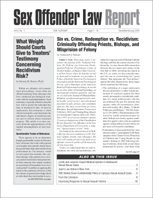Multidimensional Analysis of State Implementation of Registration and Notification Acts
Author: Ann Qurat.; Scott M. Walfield.
Source: Volume 21, Number 02, February/March 2020 , pp.17-21(5)

< previous article |next article > |return to table of contents
Abstract:
Since the passage of the Sex Offender Registration and Notification Act (SORNA), Title I of the Adam Walsh Act, in 2006, sex offender registration and notification (SORN) policies have undergone considerable expansion at both state and federal levels of government. SORNA sought to establish a baseline of standards for nationwide compliance in state law, in the hope of closing potential loopholes in SORN policies that were present as a result of state-to-state variance. As of 2019, over a decade after its passage, only 18 states have fully complied with all SORNA requirements and been deemed to have substantially implemented it. Thirty-two states remain noncompliant, despite facing a 10% loss in federal law enforcement Byrne/Justice Assistant Grant funding as a penalty for not implementing SORNA standards. That a wide majority of states do not meet federal standards appears to be a reason for concern. Indeed, framed this way, this suggests a failed policy. But a more nuanced approach shows many aspects of SORNA have been universally implemented and the barriers to full compliance are limited to a small subset of standards. This article summarizes and discusses findings from a mixed-methods study examining the state-level implementation of the Sex Offender Registration and Notification Act.Keywords: Adam Walsh Act; Sex Offender Registration and Notification Act (SORNA); State-Level Implementation of Federal Policy
Affiliations:
1: University of Massachusetts Lowell; 2: East Carolina University.